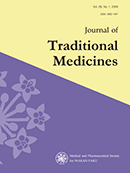Volume 30, Issue 1
Displaying 1-7 of 7 articles from this issue
- |<
- <
- 1
- >
- >|
Review
-
2013Volume 30Issue 1 Pages 1-8
Published: 2013
Released on J-STAGE: March 15, 2013
Download PDF (322K)
Review: Incentive Award, 2012
-
2013Volume 30Issue 1 Pages 9-18
Published: 2013
Released on J-STAGE: March 15, 2013
Download PDF (1540K)
Review: Symposium in the 29th Annual Meeting of Medical and Pharmaceutical Society for WAKAN-YAKU
-
2013Volume 30Issue 1 Pages 19-26
Published: 2013
Released on J-STAGE: March 15, 2013
Download PDF (2462K) -
2013Volume 30Issue 1 Pages 27-30
Published: 2013
Released on J-STAGE: March 15, 2013
Download PDF (884K) -
2013Volume 30Issue 1 Pages 31-33
Published: 2013
Released on J-STAGE: March 15, 2013
Download PDF (131K)
Regular Article
-
2013Volume 30Issue 1 Pages 34-40
Published: 2013
Released on J-STAGE: March 15, 2013
Download PDF (583K) -
2013Volume 30Issue 1 Pages 41-50
Published: 2013
Released on J-STAGE: March 15, 2013
Download PDF (1211K)
- |<
- <
- 1
- >
- >|
